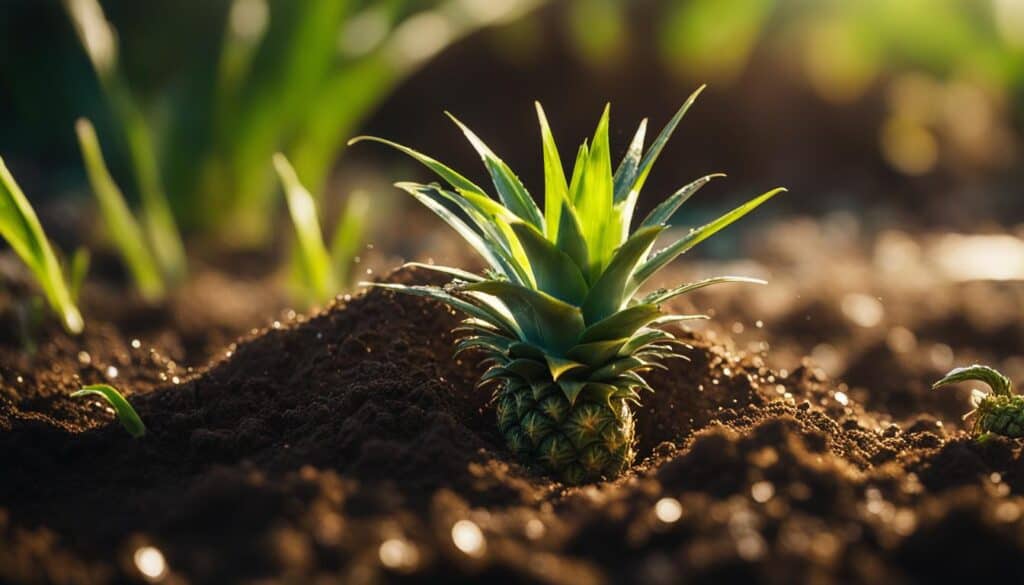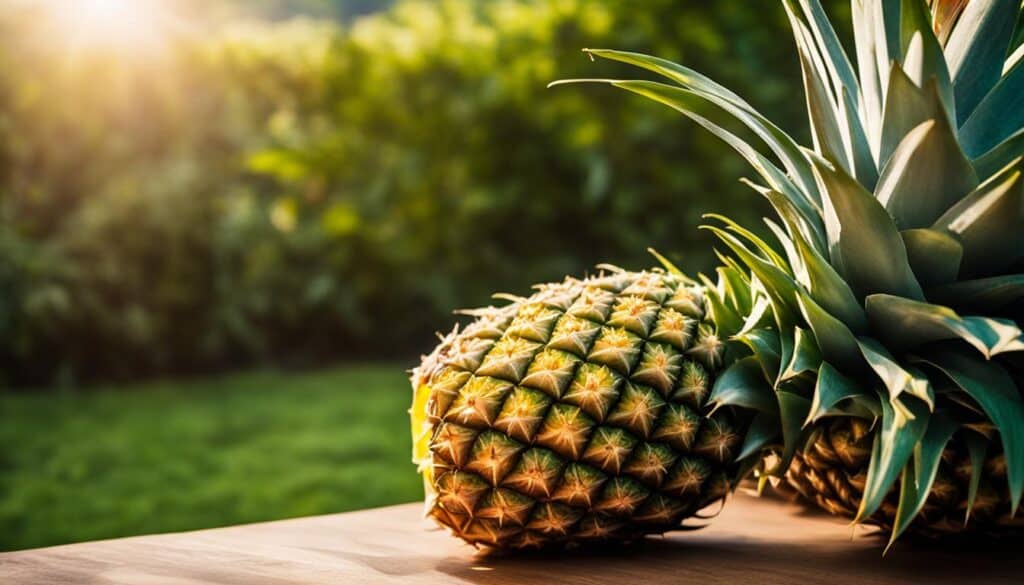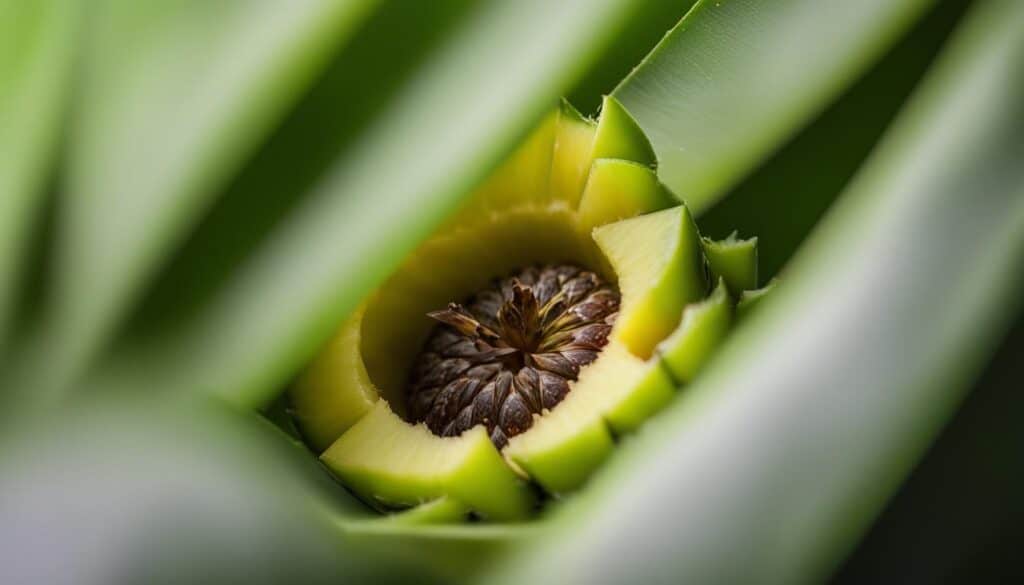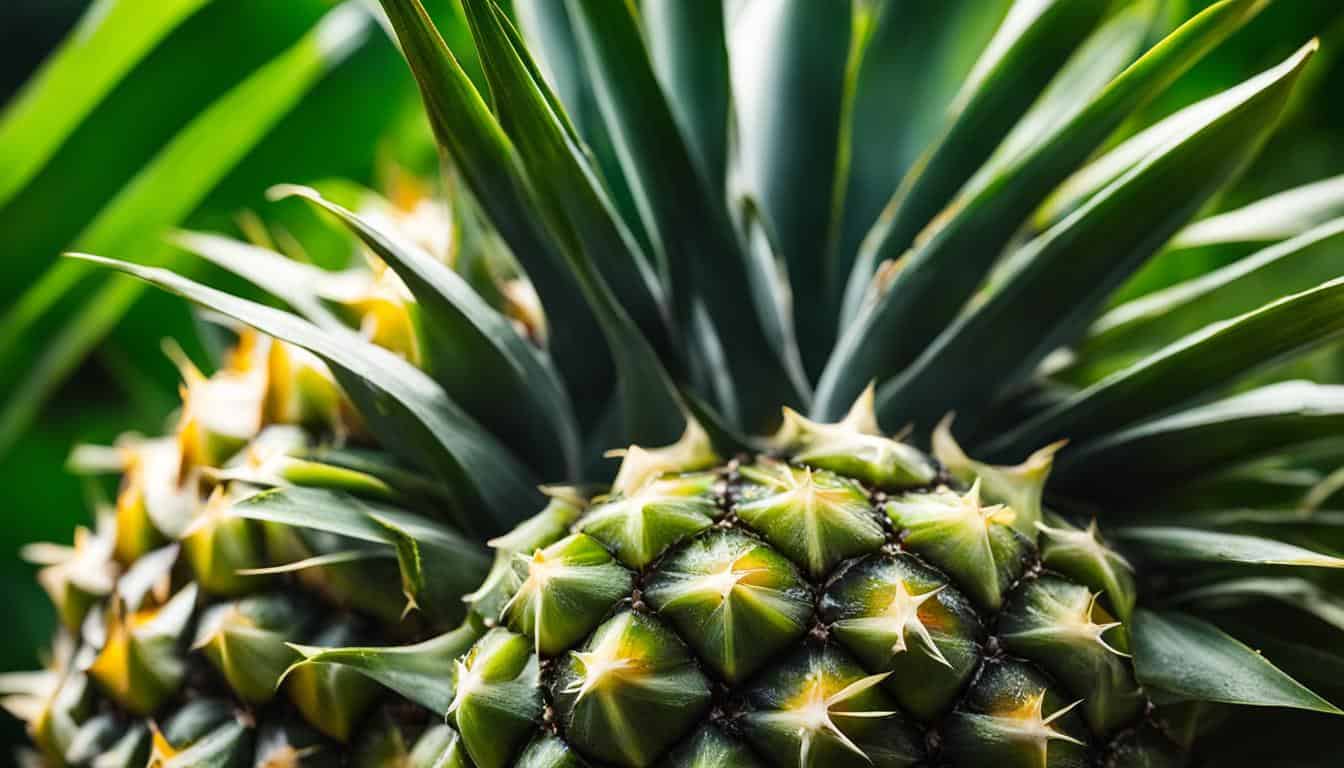Growing your own tropical flavors right from your backyard is a dream for many home gardeners. And with pineapple seeds, that dream can become a reality. Whether you choose to buy pineapple seeds from reputable suppliers or collect them from fresh pineapples, these tiny seeds offer a world of possibilities.
Not only are pineapple seeds organic, but they also provide a sense of satisfaction from growing your own food. In this article, I will guide you through the process of growing pineapple seeds and offer tips on germination and care. Get ready to enjoy the sweet taste of success!
Key Takeaways:
- Pineapple seeds can be purchased from seed suppliers or obtained from fresh pineapples.
- Choose viable and fresh seeds for optimal results.
- Germination is a crucial step in growing pineapple seeds.
- Provide the right conditions, such as warmth and moisture, for successful germination.
- Care and maintenance, including proper light, water, and nutrients, are essential for healthy pineapple plants.
What are Pineapple Seeds and How Do They Grow?
Pineapple seeds are small, black seeds found within the flesh of a pineapple fruit. They are typically harvested from fully ripe pineapples. To grow pineapple seeds, the seeds must first undergo a process called germination. This involves planting the seeds in a suitable growing medium, providing the right conditions for sprouting, and nurturing the young plants until they are ready to be transplanted. The germination process can take several weeks to months, but with proper care and maintenance, you can successfully grow pineapple plants from seeds.
During germination, it is important to keep the seeds in a warm and moist environment. The ideal temperature for pineapple seed germination is between 70-85°F (21-29°C). You can create a humid environment by covering the pots with plastic wrap or placing them in a humidity dome. This helps to retain moisture and promote successful sprouting. Once the seeds have germinated and sprouted, continue to provide them with sufficient light, water, and nutrients for healthy growth.
Growing pineapple seeds can be a rewarding experience, allowing you to enjoy the process of nurturing and witnessing the growth of these tropical plants. With patience and proper care, you can grow your own pineapple plants from seeds and savor the taste of homegrown, organic pineapples. So grab some pineapple seeds, follow the germination process, and get ready to enjoy the delights of growing your own tropical fruit.
| Key Points | Tips for Success |
|---|---|
| Harvest pineapple seeds from ripe pineapples | Choose fresh and viable seeds |
| Germination requires warm and moist conditions | Maintain a consistent temperature between 70-85°F (21-29°C) |
| Provide sufficient light, water, and nutrients | Use a well-draining potting mix |
| Monitor plants for pests and diseases | Prune the plants to maintain their shape and size |
Choosing and Planting Pineapple Seeds
When it comes to growing pineapple seeds, the first step is to choose the right seeds. You have two options: you can either buy pineapple seeds from reputable suppliers or obtain them from fresh pineapples. If you decide to buy pineapple seeds, make sure to look for trusted seed suppliers who offer high-quality seeds. On the other hand, if you prefer to collect the seeds from a fresh pineapple, select a fully ripe pineapple for the best chances of obtaining mature and viable seeds.
Once you have your pineapple seeds, it’s time to plant them. Start by filling a pot with a well-draining potting mix. This will ensure that the excess water can easily drain away and prevent waterlogging, which can be detrimental to the seeds’ growth. Plant the seeds about half an inch deep in the soil, making sure to space them evenly. After planting, lightly water the soil to provide moisture for germination.
For optimal growth, place the pots in a sunny spot that receives at least 6-8 hours of direct sunlight per day. Pineapple seeds require warmth to sprout, so it’s important to maintain a consistent temperature between 70-85°F (21-29°C). You can also cover the pots with plastic wrap or place them in a humidity dome to create a humid environment, which helps with germination.
| Choosing and Planting Pineapple Seeds | |
|---|---|
| Step 1: Choose fresh and viable seeds | Option 1: Buy from reputable suppliers |
| Option 2: Collect from fresh pineapples | |
| Step 2: Plant the seeds | Fill a pot with well-draining potting mix |
| Plant seeds half an inch deep | |
| Water the soil lightly | |
| Step 3: Provide the right conditions | Place the pots in a sunny spot |
| Maintain a consistent temperature of 70-85°F (21-29°C) | |
| Create a humid environment (optional) |
Remember, patience is key when growing pineapple seeds. The germination process can take several weeks to months, so don’t get discouraged if you don’t see immediate results. With proper care and attention, you can enjoy the satisfaction of watching your pineapple seeds grow into healthy and thriving plants.
Pineapple Seed Germination and Early Care
Growing pineapple seeds from germination to early care requires providing the right conditions and nurturing the young plants. Here are some essential steps and tips to ensure the successful growth of pineapple seeds:
Germination Process
- Plant the pineapple seeds in a well-draining potting mix.
- Maintain a consistent temperature between 70-85°F (21-29°C) to promote germination.
- Keep the soil moist, but avoid overwatering to prevent root rot.
- Create a humid environment by covering the pots with plastic wrap or using a humidity dome.
Early Care and Maintenance
- Once the seeds have germinated and sprouted, provide them with sufficient light.
- Water the young plants regularly, ensuring the soil remains evenly moist.
- Monitor the plants for any signs of pests or diseases and take appropriate actions if needed.
By following these steps, you can nurture your pineapple seeds into healthy plants and set the foundation for a successful harvest.

| Conditions for Germination | Care and Maintenance |
|---|---|
| Average temperature between 70-85°F (21-29°C) | Provide sufficient light for growth |
| Moist soil, avoiding overwatering | Regularly water the plants |
| Humid environment during germination | Monitor for pests and diseases |
Care and Maintenance of Pineapple Plants
Growing pineapple plants from seeds requires consistent care and maintenance to ensure their optimal growth and productivity. By following these guidelines, you can enjoy healthy, thriving pineapple plants in your home garden.
Light and Location
Pineapple plants thrive in bright light, so it is essential to place them in a sunny location where they can receive at least 6-8 hours of direct sunlight per day. This will help the plants photosynthesize and produce energy for growth. If growing them indoors, use artificial grow lights to provide sufficient light.
Watering
Pineapple plants prefer moist soil but should not be overwatered. It is recommended to water the plants when the top inch of soil feels dry to the touch. Avoid allowing the plants to sit in standing water as it can lead to root rot. Ensure proper drainage by using a well-draining potting mix and allowing excess water to flow out of the container.
Fertilizing
Regular fertilization is essential for the healthy growth of pineapple plants. Use a balanced fertilizer with equal amounts of nitrogen, phosphorus, and potassium. Apply the fertilizer every 2-3 months following the manufacturer’s instructions. Avoid over-fertilization, as it can lead to nutrient burn and other issues.
| Care Tips for Pineapple Plants |
|---|
| Provide bright, direct sunlight |
| Water when the top inch of soil is dry |
| Use well-draining potting mix |
| Apply balanced fertilizer every 2-3 months |
| Prune to maintain shape and size |
| Monitor for pests and diseases |
“Proper care and maintenance are crucial for the successful growth of pineapple plants. By providing adequate light, water, and nutrients, you can enjoy the beauty and taste of fresh pineapples right from your home garden.”
Pruning is another essential aspect of pineapple plant care. Remove any dead or damaged leaves and trim the plant to maintain its shape and size. This will promote air circulation and help prevent the development of fungal diseases. Additionally, regularly monitor the plants for signs of pests such as mealybugs or scale insects. If infestations occur, take prompt action to control them using organic methods or suitable insecticides.
With proper care and maintenance, your pineapple plants will grow healthy and bear fruit within 18-24 months. Enjoy the delicious flavor and nutritional benefits of homegrown pineapples while adding a tropical touch to your garden!

Harvesting and Using Pineapple Fruits
Once your pineapple plants have grown and produced fruits, it’s time to harvest and enjoy the delicious tropical flavors they offer. Harvesting pineapple fruits requires care and precision to ensure optimal ripeness and flavor. Here are the steps to follow:
- Wait for the fruits to fully ripen: Pineapple fruits are ready to be harvested when they have turned yellow or orange, depending on the variety. Avoid harvesting them when they are still green, as they won’t have reached their full sweetness.
- Twist the fruit from the plant: To harvest the ripe fruits, carefully twist them off the plant while holding the base of the fruit. Make sure to remove any attached leaves, as they can cause spoilage.
- Handle with care: Pineapple fruits can be delicate, so handle them gently to avoid bruising or damage. Place them in a basket or tray, ensuring they are not stacked on top of each other.
- Enjoy fresh or use in various recipes: Once harvested, you can enjoy the pineapple fruits fresh, cut into slices or chunks. They make a refreshing snack or a delightful addition to fruit salads and desserts. You can also use them in savory dishes like grilled pineapple salsa or pineapple stir-fry.
It’s important to note that pineapple plants typically take around 18 to 24 months to produce fruits, so patience is key when growing pineapple seeds. However, the wait is well worth it once you have a bountiful harvest of delicious, homegrown pineapples.

Table: Pineapple Fruit Recipes
| Recipe | Description |
|---|---|
| Pineapple Upside-Down Cake | A classic dessert that features caramelized pineapple slices on top of a moist cake, typically served warm. |
| Pineapple Salsa | A tangy and refreshing salsa made with diced pineapple, tomatoes, onions, cilantro, and lime juice. Perfect for dipping or topping grilled meats and fish. |
| Grilled Pineapple Skewers | Chunks of pineapple threaded onto skewers and grilled until caramelized. A sweet and smoky treat that pairs well with grilled meats and vegetables. |
| Pineapple Smoothie | A tropical beverage made with pineapple, yogurt or coconut milk, and optional additions like spinach, banana, or mango. Refreshing and nutrient-rich. |
These recipes are just a few examples of the many ways you can incorporate freshly harvested pineapple fruits into your culinary creations. Get creative and experiment with different flavor combinations to discover your own favorite pineapple recipes.
Tips for Growing Pineapple Seeds Successfully
If you’re looking to grow pineapple seeds successfully, there are several tips and tricks that can help you along the way. Whether you choose to buy pineapple seeds from reputable suppliers or opt for organic pineapple seeds, these tips will increase your chances of a thriving pineapple plant.
Choose viable and fresh seeds
When purchasing pineapple seeds, make sure they are fresh and from reliable suppliers. Look for seeds that are viable and have a high chance of germination. Alternatively, you can collect seeds from a fresh pineapple fruit. Remember to choose fully ripe pineapples for seed collection to ensure the seeds are mature and viable.
Provide the right growing conditions
Pineapple seeds require specific conditions for successful germination. Plant them in a well-draining potting mix to prevent waterlogging, as excessive moisture can hinder germination. Maintain a consistent temperature between 70-85°F (21-29°C) to create optimal conditions for growth. Place the pots in a sunny spot where the young plants can receive sufficient light.
Care for the young plants
Once the pineapple seeds have germinated and sprouted, it’s important to care for the young plants. Provide them with regular watering, ensuring the soil remains evenly moist. Avoid overwatering, as it can lead to root rot. Additionally, fertilize the plants every 2-3 months with a balanced fertilizer to provide them with essential nutrients. Regularly check for any signs of pests or diseases and take appropriate actions to protect your plants.
Monitor growth and harvest ripe fruits
As your pineapple plants grow, monitor their progress and make any necessary adjustments to their care. Pruning may be required to maintain their desired shape and size. After 18-24 months, when the fruits have fully ripened and turned yellow or orange, they can be harvested. Enjoy the delicious flavor and health benefits of your homegrown pineapple fruits.
By following these tips, you can increase your chances of successfully growing pineapple seeds. Whether you choose to buy pineapple seeds or opt for organic ones, the satisfaction of growing your own tropical delight will be all the more rewarding.

Benefits of Growing Pineapple Plants from Seeds
Growing pineapple plants from seeds offers numerous benefits that make it a worthwhile endeavor. Firstly, it allows you to enjoy the many benefits of organic pineapple seeds. By growing your own plants from seeds, you have control over the cultivation process, ensuring that no harmful chemicals or pesticides are used. This results in healthier, more organic fruits that are safe for consumption.
Secondly, growing pineapple plants from seeds provides a sense of satisfaction and connection with nature. Witnessing the growth and development of the plants from tiny seeds to mature fruit-bearing plants is a rewarding experience. It allows you to develop a deeper appreciation for the natural world and the wonders of plant life.
Lastly, growing pineapple plants from seeds promotes sustainability. By reducing your dependency on store-bought fruits, you are supporting local businesses that sell pineapple seeds. This not only benefits the environment by reducing carbon emissions associated with transportation but also contributes to the local economy. Furthermore, growing your own pineapple plants allows you to enjoy fresh, homegrown fruits, reducing the need for packaging and transportation waste.

Table: Comparison of Store-Bought Pineapples vs. Homegrown Pineapples
| Aspects | Store-Bought Pineapples | Homegrown Pineapples |
|---|---|---|
| Organic | May contain pesticides | Free from harmful chemicals |
| Taste | Variable, may be less flavorful | Sweeter, more flavorful |
| Environmental Impact | Transportation increases carbon footprint | Reduced carbon emissions from transportation |
| Economic Impact | Funds large-scale commercial farming | Supports local businesses and promotes local economy |
In conclusion, growing pineapple plants from seeds provides a range of benefits, including the ability to enjoy organic, homegrown fruits, a greater connection with nature, and a positive impact on the environment and local economy. By opting for organic pineapple seeds and nurturing them into thriving plants, you can savor the delightful taste of your own harvest and take pride in your sustainable gardening efforts.
Conclusion
In conclusion, growing pineapple seeds can be a rewarding and enjoyable experience for any home gardener. By following the proper techniques for germination and care, you can successfully cultivate your own pineapple plants and relish the tropical flavors right in your own backyard.
Throughout this article, we have explored the process of growing pineapple seeds, from selecting fresh and viable seeds to providing the optimal conditions for germination. We have also discussed the importance of ongoing care and maintenance, such as providing sufficient light, water, and nutrients, as well as monitoring for pests and diseases.
Growing pineapple plants from seeds offers numerous benefits, including the satisfaction of witnessing the growth and development of your plants and the opportunity to enjoy organic and chemical-free fruits. Additionally, cultivating pineapple seeds promotes sustainability by reducing reliance on store-bought fruits and supporting local businesses that sell pineapple seeds.
Whether you are a seasoned gardener or new to home gardening, consider adding pineapple seeds to your collection. With a little patience and dedication, you can successfully grow your own pineapple plants and savor the delicious flavors and health benefits they offer.
FAQ
Q: What are the benefits of growing pineapple seeds?
A: Growing pineapple seeds allows you to have control over the cultivation process, ensuring that no harmful chemicals or pesticides are used. It also provides a sense of satisfaction and connection with nature as you witness the growth and development of the plants. Additionally, it promotes sustainability by reducing dependency on store-bought fruits and supporting local businesses that sell pineapple seeds.
Q: Where can I buy pineapple seeds?
A: You can purchase pineapple seeds from reputable seed suppliers or collect them from fresh pineapples.
Q: How do I germinate pineapple seeds?
A: To germinate pineapple seeds, plant them in a well-draining potting mix and provide them with adequate moisture and warmth. Maintain a consistent temperature between 70-85°F (21-29°C) and keep the soil moist, but not waterlogged. You can cover the pots with plastic wrap or place them in a humidity dome to create a humid environment. Germination can take several weeks to months.
Q: How do I care for pineapple plants?
A: Pineapple plants prefer bright light, so place them in a sunny location where they can receive at least 6-8 hours of direct sunlight per day. Water the plants regularly to keep the soil evenly moist, but avoid overwatering. Fertilize the plants every 2-3 months with a balanced fertilizer. Monitor the plants for pests and diseases and take appropriate actions to protect them. Pruning may also be necessary to maintain the plant’s shape and size.
Q: When can I harvest pineapple fruits?
A: Pineapple plants take about 18-24 months to produce fruits. Once the fruits are fully ripe and have turned yellow or orange, they can be harvested. Carefully twist the fruit from the plant, making sure to remove any attached leaves.
Q: How can I increase my chances of successfully growing pineapple seeds?
A: To increase your chances of success, choose viable and fresh seeds from reputable suppliers or fresh pineapples. Use a well-draining potting mix, maintain the right temperature for germination, provide sufficient light, water, and nutrients, monitor for pests and diseases, and prune the plants as needed.
Q: What are the benefits of growing pineapple plants from seeds?
A: Growing pineapple plants from seeds allows for organic cultivation without the use of harmful chemicals or pesticides. It also provides the satisfaction of growing your own food and offers a connection with nature. Additionally, it reduces dependency on store-bought fruits and supports local businesses that sell pineapple seeds.





Leave a Reply